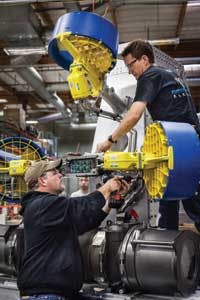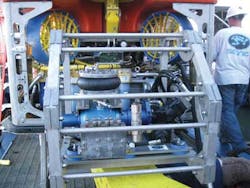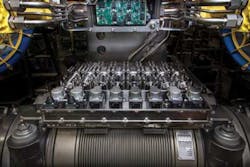ROVs evolve into underwater robots
Don Francis
Special Correspondent
Originally conceived assubsea "eyeballs," ROVs are rapidly evolving into highly capable machines that are more robot than vehicle.
Divers will not disappear, according to Tom Ayars, Seanic Ocean Systems president and a former diver himself. "In so much of theGulf [of Mexico] and the rest of the world, hardware was installed that didn't have ROV intervention built into the concept," he said. "These installations will require divers for some time to come, if not for the life of the hardware. It's old and requires hands-on with wrenches and a five-pound mall to do the stuff."
Recalled Ayars: "When I was in the field, we were convinced ROVs were going to take our jobs away. They're not. Because here in the Gulf, you've got so many platforms. There are tasks that divers regularly perform on deepwater platforms themselves, but they're clearly not diving to 5,000 ft."
Because of the physical limitations of diving, the industry recognizes thatdeepwater development will occur only with ROVs. Collaboration among operators, service companies, and ROV designers and operators is driving development of new generations of what could more accurately be called ROSRs, or remotely operated subsea robots.
Autonomous operation
Simple AUVs (autonomous underwater vehicles) are selectively used today for such things as mapping, but at some point in the future, autonomy may be far more common. In one future deepwater scenario, everything will be subsea, with modular components and resident ROVs communicating back to the platform via fiber. In such a scenario, Ayars said, "If you had the fiber system laid out, you drive up to the platform, throw the AUV over the side, which then becomes an ROV after it plugs itself in. The ROV pilot could physically be on the platform talking to it with fiber, doing a variety of infield tasks. The pilot then reprograms, unplugs, flies it to the next field, and 30 days later, as long as there are no maintenance issues, you pick it up, throw the next one in, and take the first one back for refurbishing and maintenance."
Other than the obvious distinction of tethering, a key functional difference in AUVs versus ROVs is power delivery. The AUV's primary advantage is that it doesn't need a tether or a surface vessel and has much greater mobility. But untethered operation is also a disadvantage because current AUVs can't carry a lot of power onboard. "A tether is the ROV's biggest advantage because we can send 250 horsepower down that cable and you can do all kinds of work at 100% duty cycle for as long as you wish," said Tyler Schilling, FMC Technologies Schilling Robotics president. "And then it's also its biggest disadvantage because you need the cable itself. You need a ship. You can't necessarily take certain routes because of the cable."
Reducing field costs will be a main driver of AUV/ROV vehicle development as well as development of smaller, specialist ROVs. Work-class ROVs designed for major tasks are expensive, as are the vessels and support systems they require. "If you can scale all that down and provide some specialty tooling to these midsize electric-class vehicles, they then begin to move up the food chain. Your boat gets smaller, your footprint gets smaller, and your costs get smaller," Ayars said. "Electric-class ROVs are being actively developed. There are some solid companies behind that effort, and I think they'll eventually get it done."
Schilling says ROV and AUV development are converging. "You have these two ends of the spectrum—one of them called an ROV and the other called an AUV, and they're both moving to the middle. ROVs are adopting more and more automatic behaviors and AUVs are developing the means to do contact-type tasks, whereas their original charter was always non-contact things like survey and observation."
A critical ROV component
Along with fiber optics, electronics, and hydraulics is another critical component: ROV pilots. As greater capability drives demand for greater pilot skills, the industry has responded with a wide variety of training programs. The use of simulators has proliferated. And because today's ROVs are so capable, they can make good pilots better.
The best performance from a crew and machine currently depends on the exceptional individual. Exceptional individuals get better results than average crews. But this model is not scalable, and there aren't enough exceptional individuals to go around. There are even a few "celebrities" that ROV customers have asked for by name.
Schilling thinks ROV pilot interfaces should become more like those of automobiles. "[ROVs] are far too difficult to operate as well as service and maintain. With today's automobiles, there's a button on the dash labeled 'start,' which is the user's intent. So the automobile industry, like many others, has moved from this domain where it requires expertise, and there are all these low-level ways in which you interact with the machine, to more of an intent-based interface where you just indicate to it what your desire is."
Regardless of interface, maximum ROV performance does not come from just a pilot—a skilled and talented crew is essential to maximize the uptime of these increasingly complex systems. As Ayars points out, "ROV operators would rather have highly capable techs all day long that know how to actually fix all the little stuff. That's often the most important guy to them."
ROV duties require piloting—the actual motion control of the machine itself—and then there's another set of duties that the co-pilot would normally do that ranges across what Schilling calls "hotel functions": adjusting the lighting, doing video recording activities, and running some of the tools onboard.
"The other domain of responsibility is the care and feeding of these machines," Schilling said. "You have to have people with technical competence: mechanical technician, hydraulic technician, electronics technician, and computer technician. Often, pilots and copilots have technician skills. And then you have people who are just pure technicians. Unfortunately, it takes a village at this time to run one of these."
However, ROVs using pilots have one key advantage, at least for now. It is the low-latency involvement of a human being at a remote location. In ROV operations, a human is able to make observations about the machine they are interacting with, with a latency of perhaps 50 milliseconds. Current AUV operations require acoustic transmission, which involves not only high levels of latency, but also low bandwidth.
Ayars believes ROVs represent career opportunities. "I think for young people, if they choose not to go to college, I think the ROV industry is one of the greatest things they can get into because it really does give them an opportunity to make a good living, see the world, work on something that is extremely sophisticated. And it will mature them pretty darn fast."
Interface standards
Outside of safety, the only ROV standards currently in effect are the ways in which an ROV interfaces with seafloor equipment, such as API 17D or API 17H. This will almost certainly change. For example, the DeepStar joint industry technology development project is currently working on at least one standardization project for AUV interfaces.
Pilot interface standards are a patchwork. This is not to say they are lacking; individual companies maintain their own competency schemes. But these can vary in sophistication, and there are no industry-wide standards for competency testing. This will surely change as well. Modern video analytics technologies can automatically provide a quality measure for commonly performed tasks like plugging in a hot stab. Standards can be set and users measured. "All industries go through these evolutions," Schilling said, "and it really depends on what the catalysts and drivers in the industry are in order to establish the urgency with which those evolutions or revolutions occur."
But standards, while desirable, can be a double-edged sword, Schilling believes. While improving ROV operations, they can hinder development of new ideas. "A hot stab, a torque bucket, linear override tool—it's a very constrained set of interfaces. And it was developed a long time ago. The intent was constraint, but now it's a shackle."
One of the areas Schilling's company is working on is motion control automation to enable average individuals to perform like exceptional ones. An example is their first vision-assist utilities for ROVs, which take advantage of the fact that the tools people use are designed to act along the normal axes of a subsea panel – so 90 degrees to the vertical and horizontal is how engineers intend for such things as hot stabs and torque tools to act.
"We have a pair of video cameras on the front of our ROV that when you fly up to a panel, it's able to identify that it is in fact a panel, and then it is continuously computing what the position and orientation of the panel is, so that the tool in the jaws of the manipulator arm can always be maintained normal to the panel," Schilling said. "And then all the user has to do is make it go left, right, up, down, in, out. And they don't have to worry about any of the orientation axes. The way I like to think about it is, back in 2001, we introduced a feature we call station keeping, which is dynamic positioning for ROVs. And this moves the point of interest in station keeping from the ROV body itself all the way to the tip of the tool, where it's actually the most valuable. But it's really the tip of the tool that we're automatically positioning for the user."
ROV economics
"In terms of the state of the ROV industry and its technology, I happen to believe that it's incredibly clunky and the capabilities of the machines are incredibly limited relative to the rest of the world around us now," Schilling said.
Why is it limited that way? Has the industry just decided that this is all good enough right now? Or, is there no push from it to do better?
Schilling believes the reason ROVs are so far behind is because customers are not demanding anything more than ROVs can provide at the moment. He believes the industry's current state of equilibrium exists because it's a young industry, and not too long ago, reliability was poor. "It's a measure, I think, of how young this industry is," Schilling said. "It boggles my mind, but the only true measure of productivity currently in the ROV industry is uptime. Uptime is just total time minus downtime. So this is the industry's productivity measure: Is the machine running or not? It's the most basic measure, and it hasn't graduated to any of the other measures of productivity that more evolved industries have about how well or fast or competently or consistently it does the job when it's running. So, owing to past unreliability, the industry is still saddled with this notion that you've got to make these things run."



